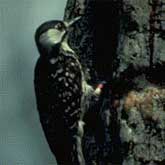The Red-Cockaded Woodpecker
 In the mid-l800s, naturalist John Audubon reported that the red-cockaded woodpecker was found abundantly in the pine forests of the southeastern United States. Historically, this woodpecker's range extended from Florida to New Jersey, as far west as Texas and Oklahoma, and inland to Missouri, Kentucky, and Tennessee. Today it is estimated that there are about 4,500 family units (groups) of red-cockaded woodpeckers, or 10,000 to 14,000 birds, living in clusters (groups of cavity trees) from Florida to Virginia and west to southeast Oklahoma and eastern Texas, representing about 1 percent of the woodpecker's original range. About the size of the common cardinal, the red-cockaded woodpecker is approximately 7 inches long (18 to 20 cm), with a wingspan of about 15 inches (35 to 38 cm). Its back is barred with black and white horizontal stripes.
In the mid-l800s, naturalist John Audubon reported that the red-cockaded woodpecker was found abundantly in the pine forests of the southeastern United States. Historically, this woodpecker's range extended from Florida to New Jersey, as far west as Texas and Oklahoma, and inland to Missouri, Kentucky, and Tennessee. Today it is estimated that there are about 4,500 family units (groups) of red-cockaded woodpeckers, or 10,000 to 14,000 birds, living in clusters (groups of cavity trees) from Florida to Virginia and west to southeast Oklahoma and eastern Texas, representing about 1 percent of the woodpecker's original range. About the size of the common cardinal, the red-cockaded woodpecker is approximately 7 inches long (18 to 20 cm), with a wingspan of about 15 inches (35 to 38 cm). Its back is barred with black and white horizontal stripes.
The red-cockaded woodpecker's most distinguishing feature is a black cap and nape (the back of the neck) that encircle large white cheek patches. Rarely visible, except perhaps during the breeding season and periods of territorial defense, the male has a small red streak on each side of its black cap called a cockade, hence its name. The red-cockaded woodpecker makes its home in mature pine forests; more specifically, those with long-leaf pines averaging 80 to 120 years old and loblolly pines averaging 70 to 100 years old. While other woodpeckers bore out cavities in dead trees where the wood is rotten and soft, the red-cockaded woodpecker is the only one which excavates cavities exclusively in living pine trees. The older pines favored by the red-cockaded woodpecker often suffer from a fungus called red heart disease which attacks the center of the trunk, causing the inner wood to become soft. Cavities generally take 1 to 3 years to excavate.
The red-cockaded woodpecker feeds mainly on beetles, ants, roaches, caterpillars, wood-boring insects, and spiders. Rat snakes are a primary predator of red-cockaded woodpeckers. Agile tree climbers, rat snakes eat woodpecker eggs and nestlings. But the red-cockaded woodpecker has an effective means of defense. It chips small holes (called resin wells) in the bark of the cavity tree, above and below the cavity. From these wells, sap (resin) oozes down the trunk of the tree. When the snake comes in contact with the sap, the sap adheres to the scales on its underside. Even tiny amounts of resin inhibit the movement of the scales, preventing the snake from climbing higher. Red-cockaded woodpeckers spend a significant amount of time and energy each day maintaining the flow of the resin wells. If the tree should die, or the damage from maintaining the wells becomes so great that the sap stops flowing, the woodpeckers will eventually abandon the cavity tree.
Fact Credit
US Fish and Wildlife Service


